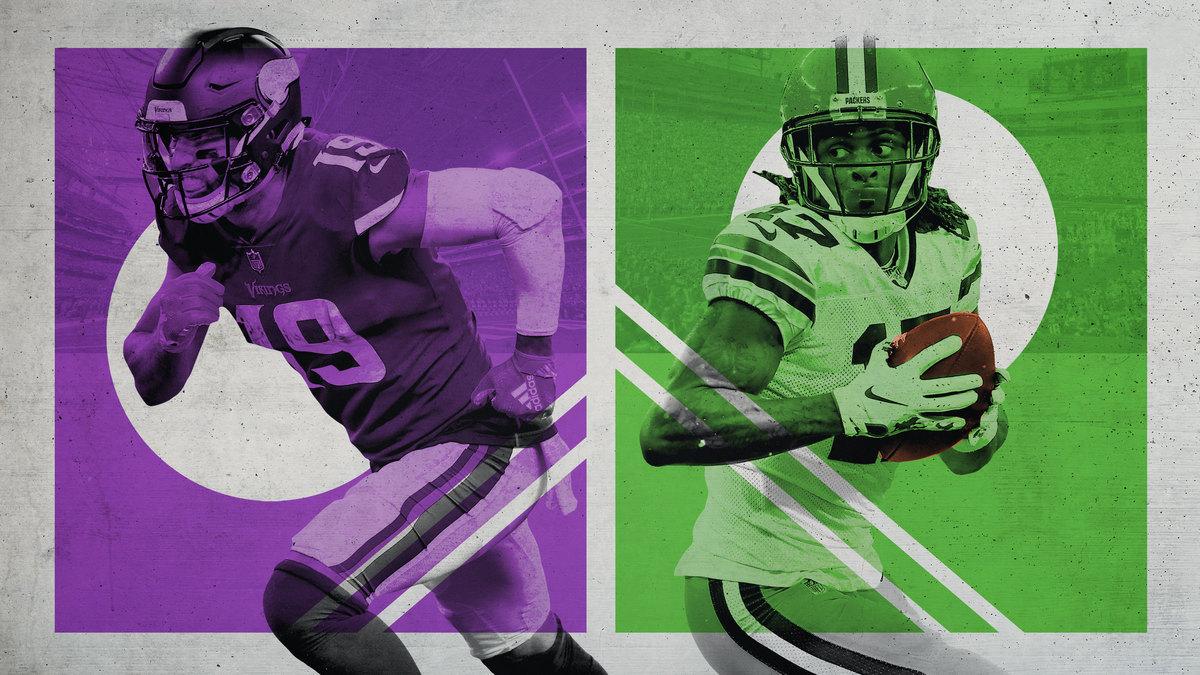The Art of the Perfect Wide Receiver Release
Just because wideouts make getting open look easy doesn’t mean it is. Davante Adams, Adam Thielen, and other receivers broke down their processes and showed how they gain an advantage over defensive backs.“One sec,” Davante Adams says as he picks up his cellphone. “I’ll show you.” It’s a Thursday afternoon in December, and Adams is standing at his locker explaining a particular receiver technique. He started out diagramming with Gatorade bottles. When that doesn’t suffice, he transitions to mimicking the movements himself. That isn’t quite enough either. Finally, he pulls up a video of the real thing. As Adams presses play, a teammate walks by and reminds him that it’s almost 3:15. They have a meeting to get to. When I apologize for taking up his time, Adams shakes his head. “Nah,” he says. “I love this shit.”
The subject at hand is receiver releases—a wideout’s initial movement to break free of a defensive back in man coverage. Adams isn’t alone in his enthusiasm for the topic. Talk to any great receiver, and it’s clear that they’ve spent more time thinking about and perfecting those few quick steps than any of us could imagine. Because while spectacular diving catches, nasty double moves, and blazing speed may get more attention, the lifeblood of the position rests in the half-second after the ball is snapped.
The late former Steelers wide receivers coaching Darryl Drake spent 15 seasons teaching the position in the NFL (and nearly two more decades in college). When I asked Drake in July which players had the best releases in the league, his initial list included three of the best receivers of the decade: Odell Beckham Jr., Michael Thomas (“as a big guy,” Drake noted), and Antonio Brown. “All those top-tier guys do a great job of getting people off ’em—because they have to,” Drake said. “They see a lot of man coverage, and they can’t let guys get their hands on them, control them, and stop them from getting into their routes as fast as they can.”
Those three wideouts may not be playing in this weekend’s divisional round games, but other great receivers like Adams, Minnesota’s Adam Thielen, and Houston’s DeAndre Hopkins are still in the hunt, fighting for their playoff lives. And their ability to gain an immediate advantage off the line could be the difference between a forgettable game and one that gets their team to Championship Sunday. “At the end of the day, how clean of a release you’re going to get dictates how much separation you’re going to get,” Thielen says. “And really, it’s your only chance of getting the ball.”
A receiver’s process for determining their initial move starts the moment they leave the huddle. Every player’s checklist differs slightly, but they hit many of the same points. And that starts with identifying the schematics of a defense.
The most basic releases (and the ones I’ll be touching on in this story) come against tight man coverage at the line of scrimmage. In today’s NFL, those have become more important than ever. Bears receiver Allen Robinson says that when he was drafted by Jacksonville in 2014, quarters coverage and routes to beat it were all the rage. Now, though, he believes all the speed at receiver has caused teams to abandon that approach. Drake also said that the amount of man coverage “increased tremendously” over the past decade and that increased speed on defense has allowed teams to adopt more man principles. “The corners are so much better,” Drake said. “They’re athletic. So you better have it.”
Robinson sees so much man now that he plans for press-man coverage every time he breaks the huddle. “I’m expecting man, and I’m adjusting to anything else,” Robinson says. “You never wanna get up to the line, and then it’s like, ‘Oh, shit, I’m getting pressed.’ You wanna get to the line, expect press, and have a plan for whatever route.”
After determining that a corner is in man coverage, receivers then have to figure out what leverage the defender is playing. If a cornerback is playing with outside leverage, a wideout might have a difficult time running an outside route like a fade. If the corner is playing inside, a slant is going to be a challenge. A cornerback’s leverage will determine how a receiver plans to attack him—which is why it’s paramount to glean that information presnap.
Usually receivers can figure out a corner’s plan based on his alignment, but that isn’t always the case. On those occasions when a corner’s positioning isn’t a dead giveaway, there are other ways of getting that info. Defensive fronts can provide hints. Four- and five-man pressures have different coverage rules, and the number of linebackers lurking in the middle of the field can impact a receiver’s options. Chargers receivers coach Phil McGeoghan says his players also look to a defense’s safety structure for clues. Whether a team is using one or two high safeties determines where a cornerback can get help from teammates. “[Defensive backs] are going to play to their help,” McGeoghan says. “That’s the no. 1 thing.”
McGeoghan has coached receivers for three different NFL teams, and he says that among all those players, Keenan Allen’s ability to identity and process that information stands out. Allen is a master at using a defense’s structure to his advantage. He knows that a single-high safety means he can manipulate factors like his split to put even more stress on a cornerback. “If it’s [a] single-high [safety], I already know the corner has outside leverage because he has help inside,” Allen says. “[If I have an inside route], I’m going to widen as much as I can—as much as the corner lets me. And he’s going to keep widening with me, because he’s supposed to be guarding outside. So that’s just creating more and more space from the inside help.”
Once a receiver plans for man and determines the leverage and structure of the defense, the final presnap step is to acknowledge the preferences and traits of the corner across from him. Like any player, cornerbacks have ticks that can be exploited. Some like to be physical in certain situations but not in others. Some will use a two-hand jam instead of a one-hand jab, depending on their alignment. Some will stay in their leverage several yards down the field no matter which way a wideout threatens them. Earlier in Allen’s career, he had trouble dealing with savvy, physical corners like Chris Harris Jr., and he noticed that other defenders started to follow suit. “They know my foot speed isn’t that good, so if they do get hands [on me], they can slow me down a lot,” Allen says. By understanding his own profile as a player, Allen is better able to account for how opposing corners are going to play him.
Falcons receiver Calvin Ridley says he has to plan ahead for corners with long arms, like teammate Isaiah Oliver, whose 33.5-inch levers can create problems for a smaller receiver. “He can sit inside, hit me with his outside arm, and use that to not even move,” Ridley says. “His [long] arms are on me, and what can I do?”
After that exhaustive presnap checklist is complete, a receiver can return their attention to their postsnap plan. And that’s where the fun begins.
I initially set out to learn more about the finer points of releases because—unlike offensive line schemes or pass-rush moves—they involve techniques I don’t know much about. It’s easy for me to see what a certain receiver did to get open; it’s another thing to understand why. Talking to some of the league’s best wideouts quickly dispelled a lot of my previously held notions.
When chatting with Robinson, I pulled up a clip from his game against the Packers in Week 1 of the 2018 season. Before the snap, Robinson is lined up in the right slot, with cornerback Tramon Williams matched up just outside of him. Robinson is supposed to run a slant on the play, which should be doable based on Williams’s outside leverage. But instead of immediately sticking his right foot in the ground and breaking inside, Robinson does a quick stutter step outside before knifing back in.
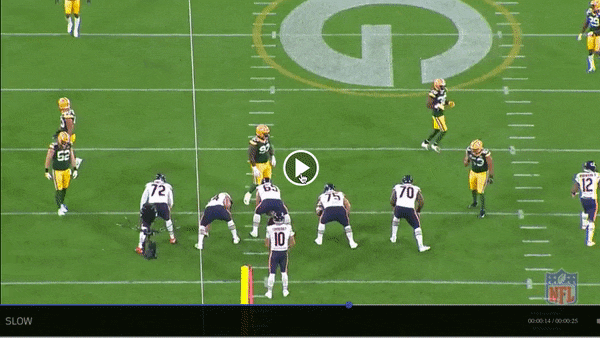
As he watches the play, Robinson explains the thought process behind stepping in the opposite direction of where he planned to go. “I’m thinking not to go inside early, to make that inside window a little bit bigger,” Robinson says.
Even if they have an advantage at the snap based on a corner’s positioning and alignment, receivers almost never immediately head toward their final destination. Corners in the league are simply too good. Even with outside leverage, a defensive back can break on a slant if he’s not forced to react to another move off the snap. A corner lined up inside against a receiver can still effectively defend a fade route if he’s allowed to turn and run on an angle at the snap. “If I have a post route, I’m not gonna run a post route from the line of scrimmage,” Adams says. “He’s gonna know that something’s up.”
With those challenges in mind, most receivers coaches teach their players a tactic called “getting even” with the cornerback. It’s a simple idea. No matter where the corner is lined up or where the receiver is trying to go, the goal is to get parallel with a flat-footed defender. There are two main objectives with that approach. The first is to mess with a corner’s expectations. “If I [go inside], he’s thinking, ‘Oh, he ain’t gonna try to come out here,’” Ridley says. The second is to create an even playing field that puts any possible route in play. “He should be thinking, ‘Damn, this guy has a two-way go,’” Ridley says.
The idea, for McGeoghan and others, is that if a receiver is even with any defensive back, the offensive player—who knows where he’s ultimately going—should win out every time. “We just want to come to balance with both feet parallel, with defenders having both feet in the earth at the same time,” McGeoghan says. “Then we can win with our transition in a millisecond.”
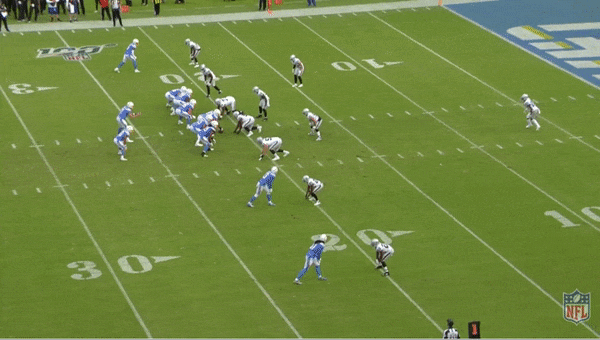
There are plenty of methodologies for how to best create that two-way go opportunity. Thielen often tries to make the start of his decoy route look like the initial movements of another concept he’s already put on tape in a similar situation. “It’s really dependent on the game plan,” Thielen says. “What other routes do we have out of that formation? Because either you’re setting it up for later, or you’ve already ran that. So I’m going to make it look like that.”
Take this pair of plays from the Vikings’ 2018 season. In Week 8, Minnesota faced a fourth-and-1 at the Saints’ 1-yard line while trailing late in the fourth quarter. Thielen lined up in the right slot, with cornerback P.J. Williams in tight man coverage. The Saints were in a heavy blitz look, and, as the play starts, Thielen is able to get even with Williams, snap off a quick slant, and snag an easy touchdown.
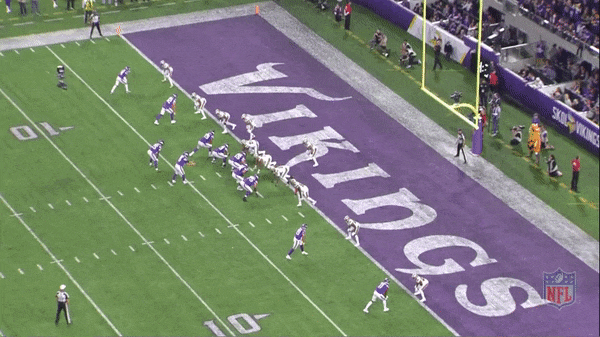
Against the Patriots five weeks later, the Vikings faced a similar situation inside New England’s 5-yard line. Minnesota lined up in a nearly identical formation, and the defense’s response clearly showed that the Pats had seen what the Vikings did out of that look earlier in the season. Safety Duron Harmon lined up with exaggerated outside leverage over Thielen, but linebacker Elandon Roberts dropped back and hovered in the exact area Thielen might attack with a slant. None of it mattered. At the snap, Thielen’s initial hesitation and feigned movement inside caught Harmon flat-footed, and the receiver was able to break outside for an easy score.
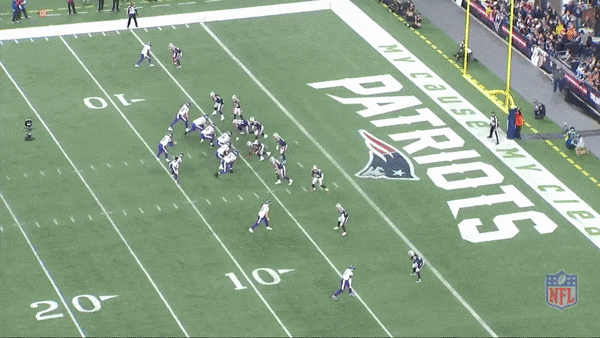
Along with challenging a defense’s expectations about alignment and formations, Robinson also likes to toy with defenders’ expectations of him. He’s earned a reputation as a deep-ball artist during his career, and he uses that notoriety to his advantage. Compared with other receivers, it’s easier for him to sell a go-route to the boundary before breaking inside. “I try to set a lot of my stuff up like I’m going deep,” Robinson says. “And there’s a good chance that I am going deep. So DBs have to respect that.”
Early in his career, Robinson struggled with getting to his routes too fast. He’d often be in a hurry and make his final break before a defensive back had even reacted. That’s an issue for a lot of young receivers, but Thielen says he runs into the opposite problem. Every so often, he’ll catch himself dancing around at the line of scrimmage, trying to do too much. “Sometimes you overthink it,” Thielen says. “Like, ‘Oh, I wanna set this up.’ Then you go back into the film room and you realize, ‘Just run.’ If I just ran here, that sells it more than anything.”
Thielen says the challenge is finding a “happy medium” between properly setting up routes to put stress on a defensive back and going fast enough to stay with the quarterback’s timing. “For me, I’m being cognizant of the time I have,” Robinson says. “Not letting the game speed me up, getting locked in on my footwork. As you get more experience, you’re able to slow the game down a little more.”
There are ground rules for how receivers should release against specific looks and leverages, but in the end, it’s just about getting open. McGeoghan thinks about it like a toolbox. He wants to give his players the right instrument for handling any situation, even if it’s not always pretty. “Just try to be creative,” Ridley says. “I take any release from anyone and try to do it my way. I can see it in my head.”
The Atlanta receiver—who’s caught 17 touchdowns in his first two seasons—says that technology has also changed the way he and other players add to their repertoires. Along with studying cutups of receivers around the league, he looks at social media accounts like Receiver Factory that post new clips every day. ‘It doesn’t matter who it is,” Ridley says. “It could be a little kid in high school. If it’s nice, I’ll do it.”
When I ask Adams about all the basic release teaching points, he bristles. “If all I do is stem in on slants, they pick up on stuff like that,” Adams says. “Just like I pick up stuff on them.” Talk to the Packers star for five minutes, and it’s clear that he thinks about this aspect of his game in a different way than most receivers. Some (excellent) wideouts like to set up their slants with a big outside step and crossover move back to the inside. For Adams, that type of exaggerated move just makes his job more difficult. “If I do [that] and go super wide, all it’s doing is making it geometrically harder for me to get back [the other] way,” he says. “Why would I do that, when I can just go vertical, and it’s still gonna pull him [with me]? If I go wide, he has a better angle to cut that off. He’s not going to shit his pants and turn and run with me.”
Now in his sixth season, Adams seems to delight in riffing on old ideas to create unique releases, and that includes the signature hop he’s developed over the years. With a practice video from last season pulled up on his phone, Adams explains the theory behind the move. “They tell you not to do it, because guys can catch you when you’re in the air,” Adams says. “But I know I have the ability to get my feet back in the ground and work. So if I jump at you and I see you start to load up, if you do lunge, and I beat you, it’s over.” Adams has learned that when he hops, most corners expect a hard crossover move inside. That gives him a golden opportunity to hit the afterburners up the sideline, even when a corner has outside leverage.
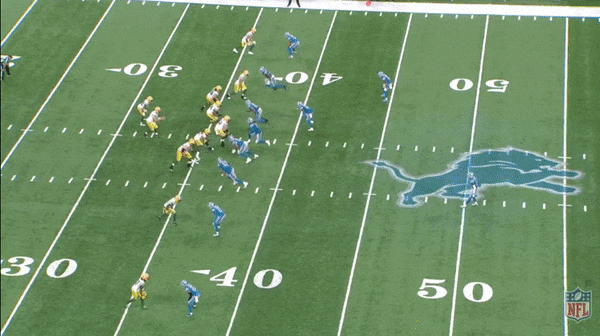
His patented move is a bit unconventional, but it accomplishes the ultimate goal of any receiver release: creating just enough cornerback hesitation from to get separation. “It feels like forever for the DB, because you’re hopping and it’s like a lull,” Adams says. “And they don’t know what’s next.”
When Adams decides the time is right, he hits corners with the devastating inside complement they were expecting the first time. “This is the marriage,” Adams says as he describes another clip. “Skip, take it [inside]. This is the exact same thing. They’ve already seen the hop and go. So they’re like, ‘Fuck, this again.’”
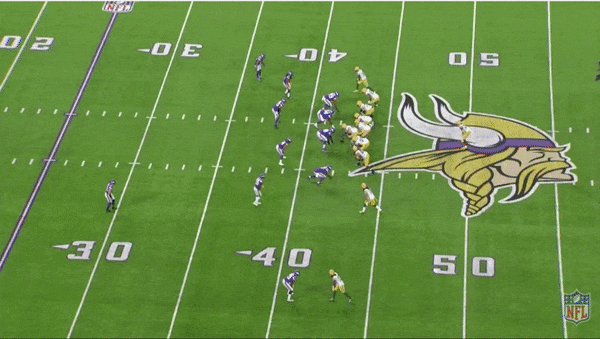
As the final part of my receiving education, Adams mentions that beyond releases, efficient moves at the top of routes—like the one against Vikings cornerback Xavier Rhodes above—are what set him apart. “That’s where people fail, usually,” Adams says. “That’s where I succeed. I’m gonna run the route how it looks, and at the top, I’ll maybe give you some sauce.” Sadly, we’ll have to save lessons about sauce for another time.
